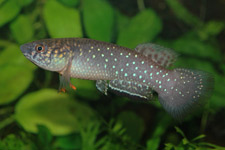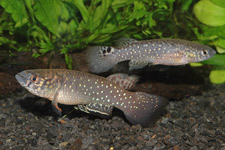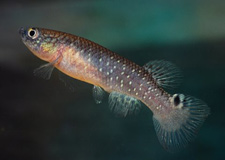History
Llanolebias stellifer was first described by Thomerson and Turner in 1973 and placed in the genus Rivulus. Later transferred to Pituna by Costa by in1989 and to Rachovia by Costa in 1998(a). See for detailed history the text under the link to Llanolebias - introduction (taken from the new genus description in 2008).
The type locality is located at Caño Benito, Venezuela.
During my one-week visit to Venezuela in November 2010, accompanied by Fernando Guerriera, I was able to recollect this species with the help of Prof. Oscar Leon Mata and Prof. Otto Castilo.
It was found in a temporary pool along the road from Guanare to Guanarito. In this pool that was under thick cover of trees, we also found Gnatholebias hoignei and Rachovia maculipinnis. The pool was close to the road but it was not possible to see it because of the vegetation. Water level was about 60 cm in the middle. Water was turbid and had a layer of duckweed on its surface. pH was about 6.2 and temperature about 26 C.
Reproduction
Breeding is not to difficult but the males and females are rather aggressive to each other. So you need a tank that is of not to small size and some hiding places must be offered. It is wise to put one male with more females but as also the females can get aggressive to each other it still can come to fights that result in damaged fins and sometimes to death. The species normally dives deep into the substrate to spawn but....if no deep layer is at hand they also spawn against the substrate that is lying on the bottom of the tank.
Eggs are amber colored and about 1.8 mm in size. The incubation time will be about 3 - 4 months.
I do not have experience myself yet with the developing time the eggs need (dec.2010.. I just start with breeding the species) and will be more precise as soon as I have more data to share.
This species was several times in the hobby but always it disappeared soon thereafter. I hope to send eggs to people who like to keep this one in the hobby for a longer period of time.
As you can see on the images the males and females as well have breathtaking colors and are worthwhile to maintained in our aquariums for decennia to come.
Variations
Map
Meristics
Max. size 7.5 cm.
Dorsal 11.0,
Anal 16.0,
D/A 9.0,
LL scale count (average)35.0
Pre- dorsal length to % SL – 72.0 %
Depth to % SL – 22.0 %
Literature
Hrbek, T. and D.C. Taphorn, 2008. Description of a new annual rivulid killifish genus from Venezuela. Zootaxa 1734: 27–42
Thomerson, J.E. & B.J. Turner. 1973. Rivulus stellifer, a new Species of annual Killifish from the Orinoco Basin of Venezuela. Copeia: 783, figs. 1-2.


